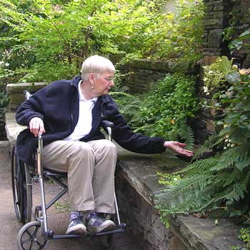Professional Practice
Adult: Alzheimers and Dementia

According to the Alzheimer’s Association, one in three seniors dies with some form of Alzheimer’s or dementia, and Alzheimer’s is the sixth leading cause of death in the United States. In 2013, Alzheimer’s cost the United States $203 billion, with an expected increase to $1.2 trillion by 2050.
 ASLA 2010 Professional Research Honor Award, Access to Nature for Older Adults: Promoting Health Through Landscape Design, Multi-Regional USA, Center for Health Systems & Design, Texas A&M University / Image Credit: Susan Rodiek
ASLA 2010 Professional Research Honor Award, Access to Nature for Older Adults: Promoting Health Through Landscape Design, Multi-Regional USA, Center for Health Systems & Design, Texas A&M University / Image Credit: Susan Rodiek ASLA 2006 Professional General Design Honor Award, The Elizabeth & Nona Evans Restorative Garden, Cleveland Botanical, Cleveland, Ohio, Dirtworks, PC / Image credit: K. Duteil
ASLA 2006 Professional General Design Honor Award, The Elizabeth & Nona Evans Restorative Garden, Cleveland Botanical, Cleveland, Ohio, Dirtworks, PC / Image credit: K. DuteilHow Nature Helps
There is something innate about our connection to nature. A study published in the American Journal of Alzheimer’s Disease & Other Dementias, shows that long-suffering dementia and Alzheimer’s patients are known to have decreased symptoms following time in gardens or being exposed to horticultural therapy.
Research
"Comparing Responses to Horticultural-Based and Traditional Activities in Dementia Care Programs," American Journal of Alzheimer’s Disease and Other Dementias, 2010
"Does a Wander Garden Influence Inappropriate Behaviors in Dementia Patients?", American Journal of Alzheimer’s Disease and Other Dementias, 2008
“Outdoor Environments for People with Dementia,” Rodiek and Schwarz, 2007
"Effects of Horticulture Therapy on Engagement and Affect," Canadian Journal on Aging, 2005
Resources
Therapeutic Landscape Network
Organizations
The American Horticultural Therapy Association
Role of the Landscape Architect
Landscape architects design therapeutic gardens for use in nursing homes, which are not only known to decrease the symptoms of the patients suffering from neurological disorders like dementia and Alzheimer’s, but also decrease the stress and anxiety of the care-takers and nurses in these facilities. Taking care to address the needs of the aged and patients suffering from these disorders, landscape architects design gardens with paved paths for ease of walking, ample places to sit, raised planting beds to be enjoyed by people in wheel chairs and ample opportunity for people to be engaged with via the senses smell and touch, as well as sight.
Case Studies
Elizabeth & Nona Evans Restorative Gardens, Cleveland, Ohio, Dirtworks, PC
Design for Older Patients in Nursing Homes, Center for Health Systems and Design
Asthma & Respiratory Disorders >>